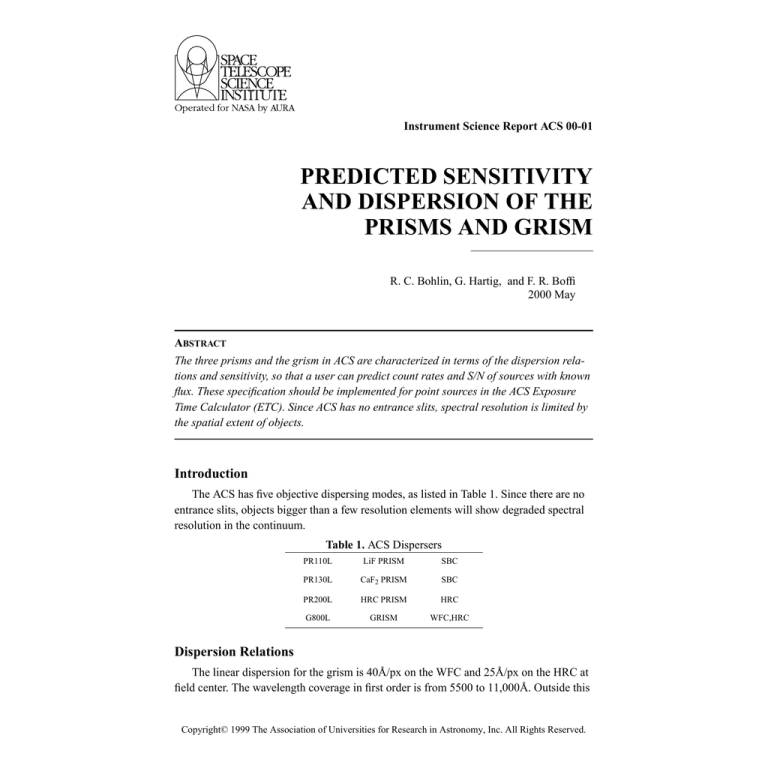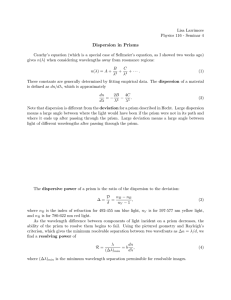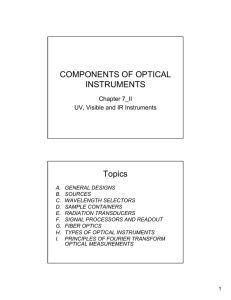
Instrument Science Report ACS 00-01
PREDICTED SENSITIVITY
AND DISPERSION OF THE
PRISMS AND GRISM
R. C. Bohlin, G. Hartig, and F. R. Boffi
2000 May
ABSTRACT
The three prisms and the grism in ACS are characterized in terms of the dispersion relations and sensitivity, so that a user can predict count rates and S/N of sources with known
flux. These specification should be implemented for point sources in the ACS Exposure
Time Calculator (ETC). Since ACS has no entrance slits, spectral resolution is limited by
the spatial extent of objects.
Introduction
The ACS has five objective dispersing modes, as listed in Table 1. Since there are no
entrance slits, objects bigger than a few resolution elements will show degraded spectral
resolution in the continuum.
Table 1. ACS Dispersers
PR110L
LiF PRISM
SBC
PR130L
CaF2 PRISM
SBC
PR200L
HRC PRISM
HRC
G800L
GRISM
WFC,HRC
Dispersion Relations
The linear dispersion for the grism is 40Å/px on the WFC and 25Å/px on the HRC at
field center. The wavelength coverage in first order is from 5500 to 11,000Å. Outside this
Copyright© 1999 The Association of Universities for Research in Astronomy, Inc. All Rights Reserved.
Instrument Science Report ACS 00-01
range, the sensitivity is only a few percent of the peak throughput at 7000A. Beyond
~11000Å, the first order spectrum lies on top of the second order.
The dispersions of the three prism modes are defined by meaurements of monochromatic spectra obtained in 1999 May. D. Lindler fit these wavelength vs. pixel (X) data with
the usual FOS and STIS dispersion relation:
wavelength (Angstroms) = a1 + a2/X + a3/X2 + a4/X3 + a5/X4
where: X = (pixel position - a0)
The dispersion Å/Pixel is:
abs( a2/X2 + 2*a3/X3 + 3*a4/X4 + 4*a5/X5 ).
For PR110L and PR230L, x is <0, while x>0 for PR200L.
Results are tabulated below. The position of the prism on the detector is determined by
the a0 coefficient, which is the pixel position for the long wavelength limit of the spectrum. The choices for a0 in Table 2 represent the dispersion at field center, while the
dispersion varies by a total of 6% over the tilted focal plane for the SBC and HRC. The
total dispersion variation for G800L on the WFC is 24%.
Table 2. Prism Dispersion Coefficients
LiF PRISM
CaF2 PRISM
a0 =
339.33770
354.03448
870.12088
a1 =
1051.6163
1071.7806
1133.2426
a2 =
21150.558
-14967.555
82999.557
a3 =
9237490.7
1947999.0
-828929.38
a4 =
4.9340281e+08
54848094.
-4653501.0
a5 =
1.2458532e+10
1.1163562e+09
1.6888817e+08
RMS of fit =
0.18 pixels
0.11 pixels
0.13 pixels
HRC PRISM
Sensitivity
The throughput efficiency of the optical elements have been measured in the lab and
are compiled for the dispersers and filters by Z. Tsvetanov at http://adcam.pha.jhu.edu/filters/tables/Master_Table.html. All of the optical elements are entered in the STScI
Synphot system (1998), which is used to compute the total system throughput for the combined instrumental and OTA efficiencies as a function of wavelength. The total system
sensitivity summed in the cross-dispersion direction but per pixel in the wavelength direction is shown in Figures 1-5 for the five dispersers with a diamond at every pixel. Notice
the coarse spacing of the pixels near the long wavelength limits of the three prisms. In particular, PR200L in Figure 3 has little dispersion in the few pixels at the bright head of the
2
Instrument Science Report ACS 00-01
spectrum beyond ~4000Å. The RMS of the fits do not apply at the longest wavelength,
where the dispersion has not been measured. Since the SBC cathode cuts off sharply
beyond 2000Å, the chromospheric lines below 2000Å dominate the signal for bright, cool
sources; and the bright object limits can be established per Boffi and Bohlin (1999) without a precise long wavelength dispersion relation.
Sky Background
Because ACS has no entrance slits and obtains only objective spectra of objects over
the whole field, the background at each pixel is determined by the sky brightness integrated over the entire passband of the system throughput. The sky background will be
worst in the CCD modes and in PR110L, which includes the bright Ly-α geocoronal line.
For example, the daytime sky is about 20kR at Ly-α, which produces ~0.03 count per sec
per pixel with the PR110L, while the CaF2 PR130L does not transmit Ly-α and has about
a 10x lower sky background signal.
REFERENCES
Synphot User’s Guide 1998, (Baltimore:STScI).
Boffi, F. R., & Bohlin, R. C. 1999, ISR ACS 99-07, (Baltimore:STScI).
3
Instrument Science Report ACS 00-01
Figure 1: Sensitivity for point sources as a function of wavelength for PR110L. A diamond is plotted at the wavelength of each pixel. The units of the ordinate are the response
of the detector in counts per second per pixel in the wavelength direction, as summed over
pixels perpendicular to the dispersion, per unit flux of the point source in erg s-1 cm-2 Å-1.
4
Instrument Science Report ACS 00-01
Figure 2: As in Figure 1 for PR130L.
Figure 3: As in Figure 1 for PR200L.
5
Instrument Science Report ACS 00-01
Figure 4: As in Figure 1 for G800L on the WFC.
Figure 5: As in Figure 1 for G800L on the HRC.
6








